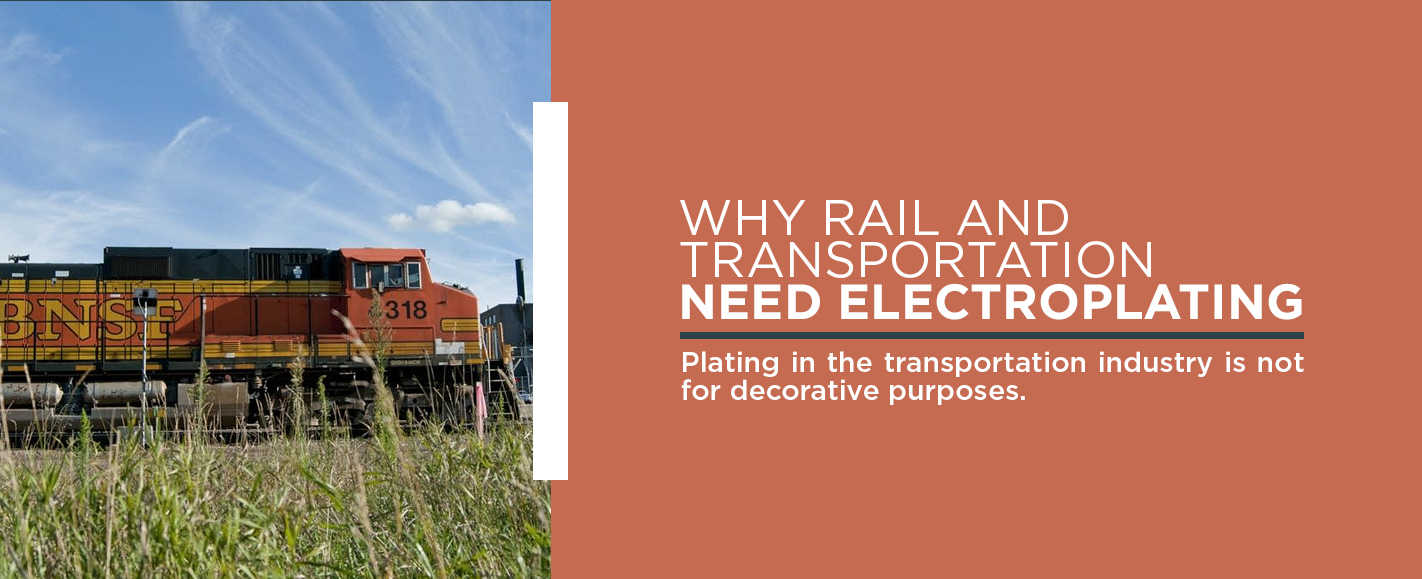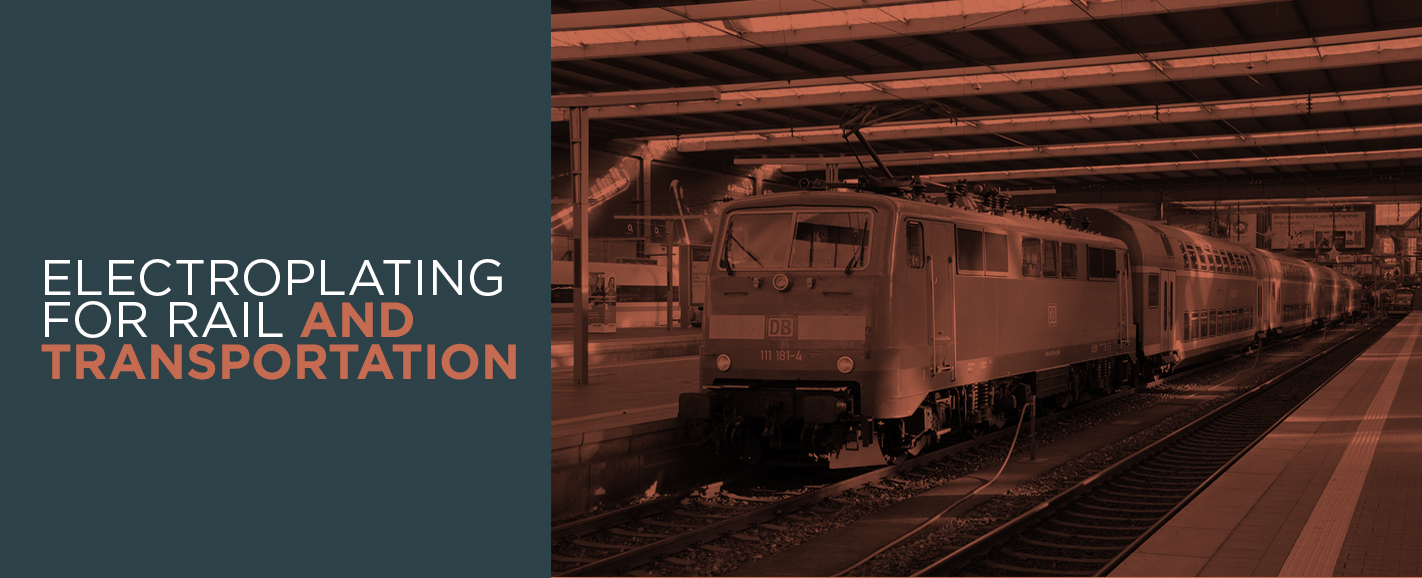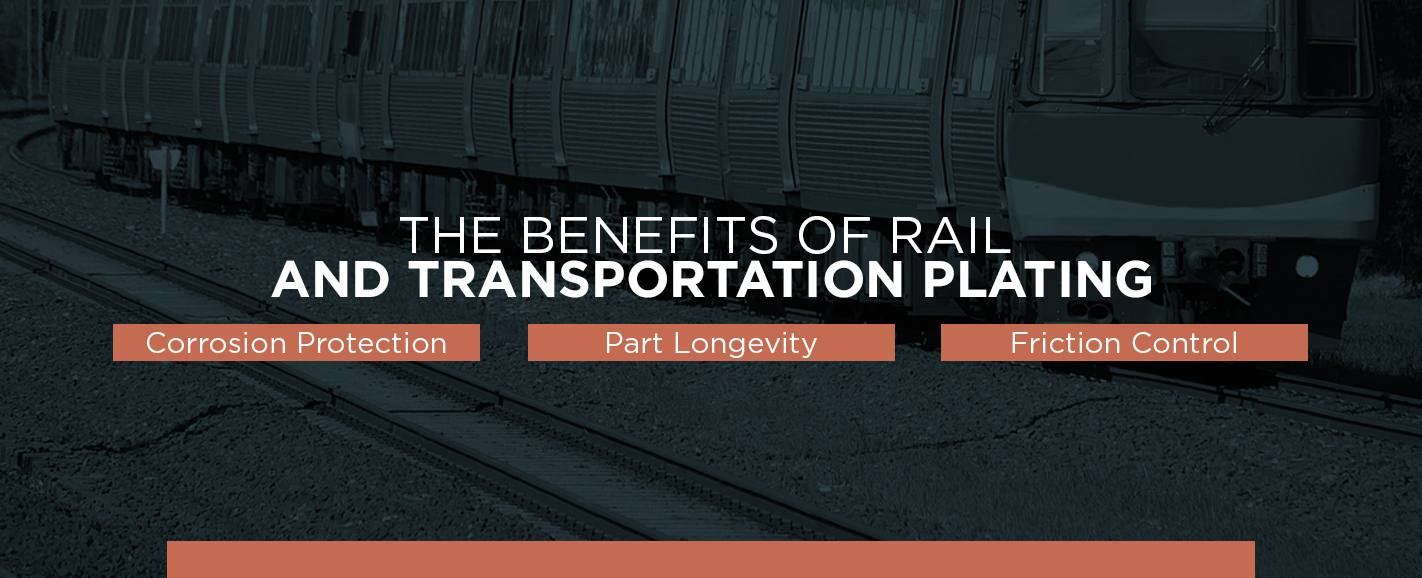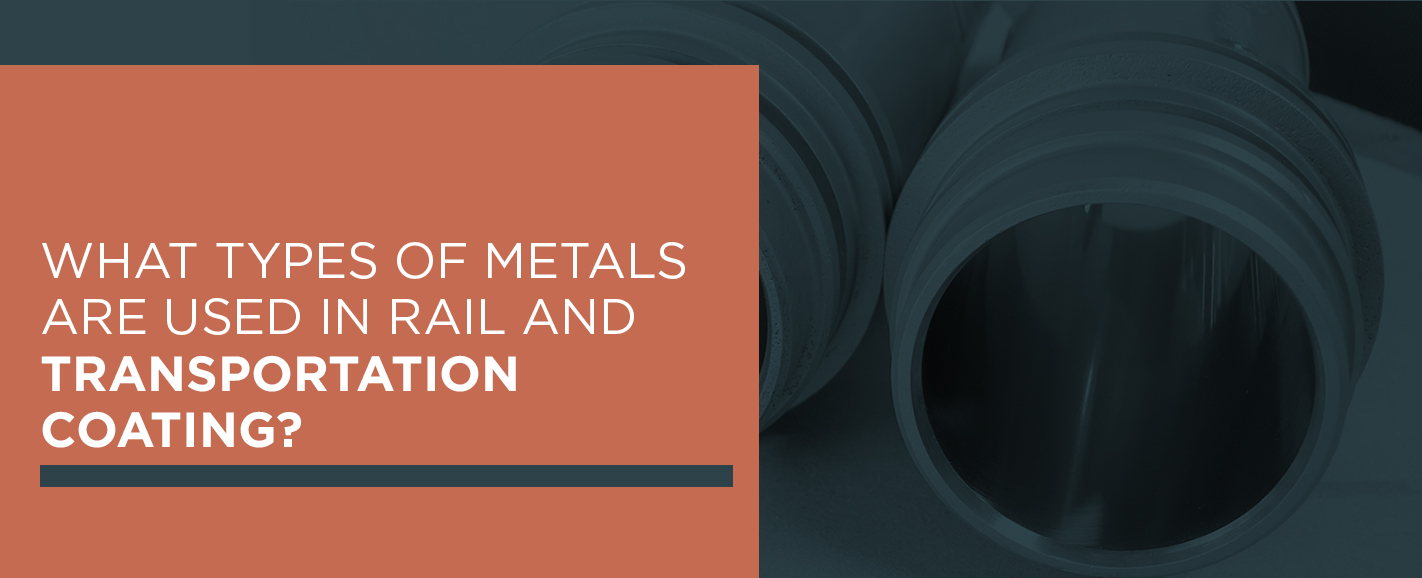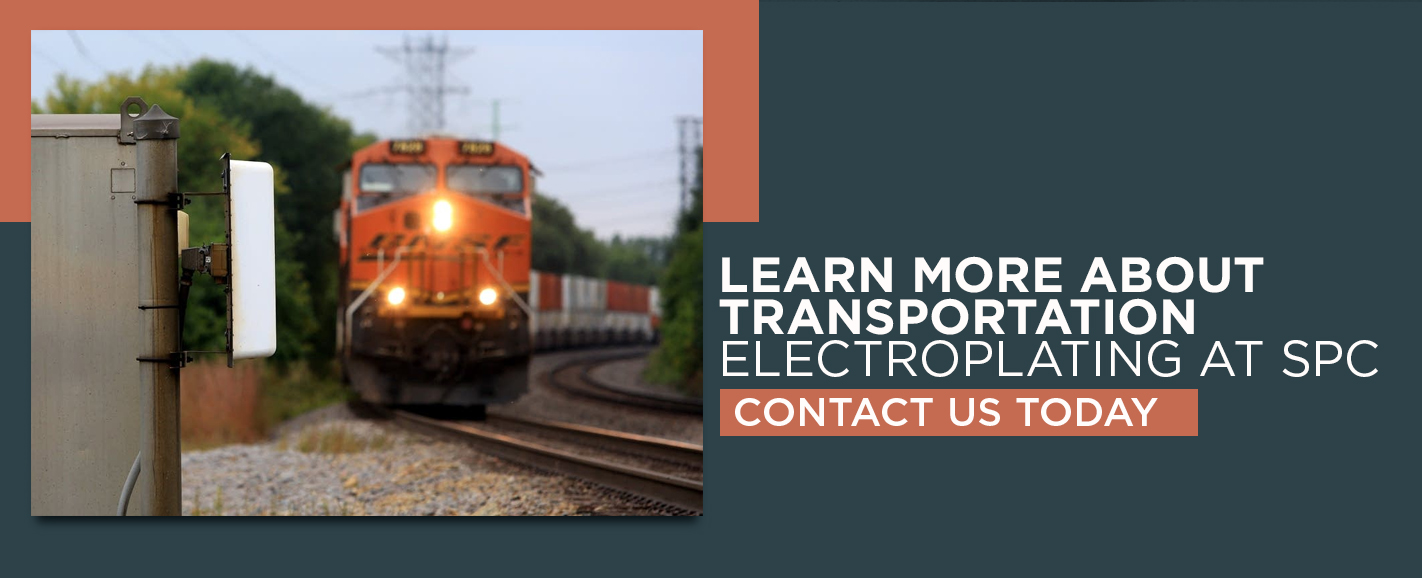Railroads remain an integral part of the American transportation industry. To keep rail pushing forward into the future, components of trains must continue to evolve. Innovative and traditionally trusted metal coatings and finishes allow vehicles to keep running in all types of weather with less wear compared to untreated surfaces. Electroplating brings those necessary finishes to rail components. It has been a staple of the railroad industry for over a century, with a 1913 publication noting that electroplating iron and steel with lead had been done for years to protect the metal. Thanks to plating techniques such as those noted in the century-old reference, railroads continue to play a significant role in the transportation industry, and innovating coatings will continue to take transportation into the future.
Why Rail and Transportation Need Electroplating
Plating in the transportation industry is not for decorative purposes. The metal coating on the exterior protects the interior surface while extending the part’s life, which for rails can be up to 60 years or more. Compared to other methods of construction and finishing, electroplating may cost less because it extends the use of more expensive metals. For large-scale transportation projects, saving a small amount of money on one aspect will add up to more significant savings over the entire project.
Trains and other forms of transportation are always outside, exposed to rain, sun and temperature extremes. Metal tends to corrode in such conditions. But coating the base metal with a harder finish keeps those components in the open lasting longer. Rail fasteners and clamps are just two parts along the tracks that must resist corrosion and scratches. A tough coating on these parts helps them last longer in the field, keeping the rails safer and increasing the time required between repairs.
For electrical components of transportation systems, electroplating coats parts with more conductive metals, improving electrical connections. Gold and silver, though pricey for large-scale use, are highly conductive and ideal for electrical connections. Silver has been frequently used for printed circuit boards since the 1970s. With the various electronics in vehicles and control systems, this use of electroplating has risen to greater importance today compared to in the past. Future applications of silver electroplating include solar cell conductors, which could become a part of the transportation industry as an alternative fuel source.
Though electroplating requires an additional step in the manufacture of transportation parts, it offers many benefits. Due to the industry's strict requirements for safe operation and construction, electroplating is often required for modern transportation components.
The Benefits of Rail and Transportation Plating
Plating has several benefits for rail and transportation. It protects surfaces exposed to extreme conditions and increases part longevity. Electroplating does more than make the parts last longer. In the transportation industry, improved part longevity and reliability enhance the safety of the entire system.
1. Corrosion Protection
Corrosion can come from several sources. Wear by salt in the air due to sea spray, blown sand in desert environments and moisture-causing rust all can compromise the integrity of train and transportation parts. The amount of corrosion depends on the exposure the pieces have to the elements and the particular environment in which they're used.
The surfaces of rail cars and rail beds are regularly under attack from the elements, and corrosive materials carried by the vehicles could spill onto these surfaces. To extend these parts' lifespans, applying an electroplated coating will help.
In moist conditions, water can rust iron, but when iron parts have an electroplated coating, they do not rust as quickly. Rust resistance is essential in transportation parts because any rust indicates wear in the metal. Rust resistance prevents components from prematurely wearing. Worn metal in transportation systems poses more than an inconvenience. It can be a safety hazard. Electroplated iron parts can ultimately save lives by preventing rust and subsequent weakness.
One type of electroplated finish that has yet to be fully embraced by the rail industry is a zinc-nickel alloy. Compared to only a zinc coating, a zinc-nickel coating with 12 to 16 percent nickel, has a four times greater success in the SAE J2334 cyclic corrosion test.
2. Part Longevity
Parts coated with metal through electroplating last longer because they have a higher resistance to wear. Adding steps to the finishing process can increase the useful life of parts even more. For instance, when a piece coated with cadmium gets a chrome finish, it will last even longer. Chrome helps cut down on friction between parts and galling, both of which can help parts last longer.
For hot temperature environments, such as those in the engines of transport vehicles, the heat resistance of the parts contributes to how long the components last. Pieces coated with zinc-nickel alloy withstand high temperatures better than parts without such a finish. The zinc-nickel alloy allows parts to maintain damage resistance at temperatures up to 200 degrees Celsius.
For some parts, rather than replacing them, recoating them with a fresh finish may help them last longer. Compared to purchasing new pieces, replating is a more economical option.
3. Friction Control
Friction is undesirable between parts that must move against each other, such as bearings or gears. Some parts, like brakes, require high levels of friction for proper operation. In other cases, the friction level cannot be too high or low, or fasteners will not fit and hold. The resistance of various levels depends on multiple factors, including the finish of the part. For many components of transport vehicles, creating the ideal coating on adjacent parts based on their use can have a significant impact on the longevity of those parts.
Electroplating cuts down on wear in its ability to reduce friction between parts. Opting for lower friction coatings can slow the wear between metal components. The parts operate smoother with less friction between them, and the lack of excess friction keeps temperatures down, too. When connecting parts, the friction levels are essential, also. With vehicles, about 85 percent of problems come from issues during assembly, including poorly connecting joints.
Certain metal finishes can improve the amount of friction. For instance, cadmium has a low-friction rating. Zinc-nickel alloys also reduce friction while they increase the hardness of the finished part. While the coating affects the friction of various parts, it is not the only thing that influences the amount of friction. The cleanliness of the parts and whether the lubrication of the components also affect friction.
4. Electromagnetic Interference Reduction
For transportation, mass transit systems often generate elevated levels of electromagnetic interference (EMI). Electroplating provides shielding from high EMI levels, which can interfere with control systems. Even the operations of mass transit vehicles can produce EMI. Protecting controls and vehicle electronics, whether they are on a plane or train, becomes vital to preventing a loss of control.
While most EMI shields are made of plastics on the inside, the outside must have an EMI shield. Electroplating to create an EMI shield has an advantage over electroless plating in its ability to create multiple layers over the entire surface. With multiple layers, the electroplated EMI shield looks better, resists wear more effectively and shields from EMI more. This finish is ideal for outer EMI shields where appearance is almost as important as blocking interference.
Reducing interference helps keep modern transportation systems running. Electroplating benefits safety and control systems in ways those who pioneered the process over a century ago could never have imagined.
What Types of Metals Are Used in Rail and Transportation Coating?
The rail and transportation industry require several different metals and alloys in the construction of their parts. How the metals withstand various stresses and their costs are some of the considerations that factor into which metals are used in coatings and base materials. These are some of the materials used commonly used for electroplating in the transportation industry:
- Hard chrome: Hard chrome appeals to those constructing vehicles and parts with exposure to salts, such as boat builders or those constructing in coastal communities. While the hard chrome itself is resistant to sticking and friction, it also protects iron in environments with high salinity.
- Cadmium: Cadmium plating is frequently used for fasteners, frameworks and bolts in automobiles and other vehicles. Its low friction level makes cadmium an ideal coating for these moving parts and fasteners. Electroplating accounts for 90 percent of cadmium's use in coatings. When applied onto iron, brass, aluminum or steel, cadmium increases the corrosion resistance, especially in salty environments.
- Nickel: Nickel provides a durable barrier to wear and corrosion. Multiple layers of nickel improve corrosion protection beyond that achieved by a single layer. Additionally, many automotive parts use nickel both for corrosion protection and for its brilliant shine. When creating EMI shields atop plastic bases, a layer of a nickel-phosphorous alloy is electrolessly applied to the plastic. This conductive material allows for the surface metal to adhere during electroplating.
- Silver: Silver, like gold, is often used for metal connections on circuit boards and in other electronics. Applying silver onto the base metals reduces the amount of silver used, which lowers the cost. The conductivity of the silver is not compromised, though.
- Tin: A coating of tin on any base metal will make the item more corrosion resistant. Tin coatings perform well in high-stress situations. In its pure form, tin has effective use as an EMI shield, especially when using matte tin rather than bright tin.
- Tin-Lead alloys: Like precious metals, tin-lead alloys excel at conductivity, making them ideal for use in electronics. It's also easy to solder, again, creating a perfect metal for use in electronics. Combining tin with lead for use in electronics reduces the chance of the tin producing "whiskers," which can create dangerous arcs that could short out the circuit. Unfortunately, tin-lead alloys are not friendly to the environment, pushing the drive for alternatives, such as pure tin.
- Zinc: Zinc coatings reduce corrosion. When using a zinc-nickel alloy, the benefits increase. Zinc-nickel alloys offer better protection against high temperatures, better wear resistance and greater corrosion prevention.
Request a free quote
For Medical Plating
Sharretts Plating Company: The Best Choice for Your Rail and Transportation Plating Needs
SPC stands apart from other plating companies for our longevity in the business and our expertise. Since our company's founding in 1925, we have been driving innovation in surface treatments. We know about the best ways to coat surfaces and create new methods for finishing. We hold the patent for the novel nickel-boron finishing process, an advancement which our competitors cannot match.
For rail and transportation plating, we continue our legacy of quality and innovation. Our services are for commercial and industrial customers and are selected for their longevity and durability. We also have vast experience in plating plastics to create EMI shields to protect control systems. These characteristics of plated components help lengthen their lives when put through the rigors of daily use in transportation while keeping the vehicles in the system safe.
We know how to work with a variety of different metals when electroplating. Because we're so well versed in which metals to use to achieve various results, we can help you choose the best finish for your rail and transportation needs. Let us know what parts you need to be coated and what you need them to do. We can help you with the finish that will perform to your expectations, whether you need low-friction, longevity, hardness or a combination of all these.
We are here to help you improve your transportation business with plating solutions to solve problems inherent in the industry. Increasing the lifespan of materials, rejuvenating parts, protecting from EMI and more are just some of the things we do at SPC.
Learn More About Transportation Electroplating at SPC
Electroplating in the transportation industry remains a vital part of creating and maintaining parts designed for years of use in harsh elements. Thanks to the many means of plating, trains and their components become stronger and last longer. By plating onto plastics, we can protect your control systems from electromagnetic interference. These are just a few of the ways SPC can make the transportation industry better.
If you want to learn more about electroplating for the transportation industry, contact us at SPC. As a specialized coating company with more than 90 years of experience, we are experts in our field. Let us assist you in finding the answers to any questions you have about plating or contact us to handle your transportation plating projects.
Additional Resources:
Get a free quote for our plating and coating in transportation applications. You can schedule an on-site consultation at your convenience so we can recommend the best medical device coating solution for your needs and budget.
LEARN WHAT OUR MANY SATISFIED CUSTOMERS HAVE TO SAY ABOUT Us
"I would like to thank you for the help you have provided us in developing an electroless nickel plating technique on an unusual substrate. The sample platings you provided show that we should be able to reach our goals. I especially appreciate your willingness to take on an unusual job, with the uncertainties that that entails...We are looking forward to working with you in the future on our plating needs."
– Robert K.


